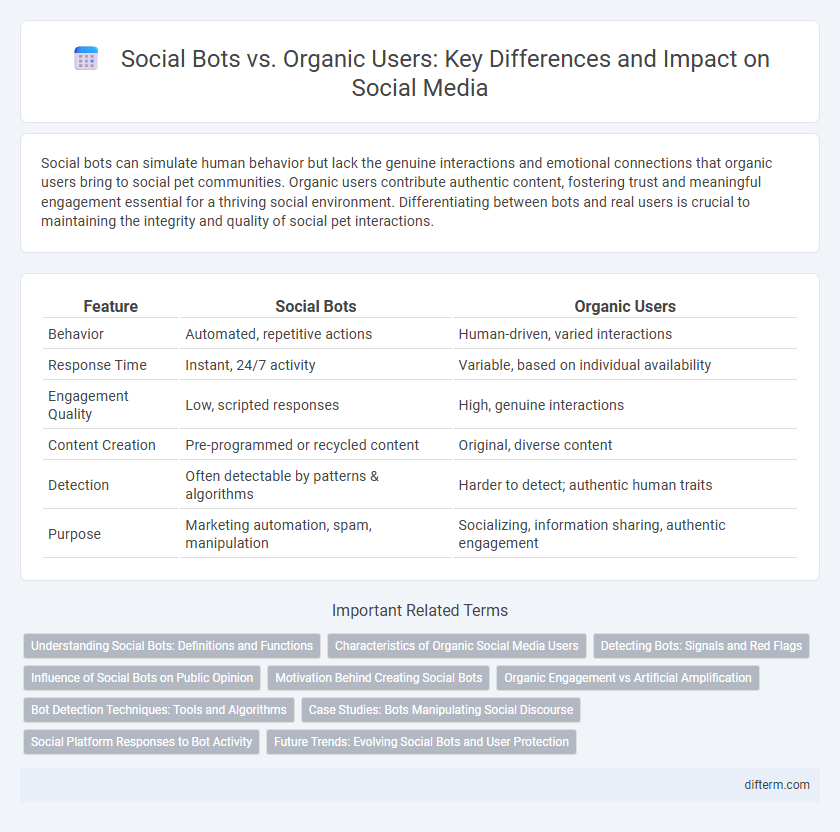Social bots can simulate human behavior but lack the genuine interactions and emotional connections that organic users bring to social pet communities. Organic users contribute authentic content, fostering trust and meaningful engagement essential for a thriving social environment. Differentiating between bots and real users is crucial to maintaining the integrity and quality of social pet interactions.
Table of Comparison
| Feature | Social Bots | Organic Users |
|---|---|---|
| Behavior | Automated, repetitive actions | Human-driven, varied interactions |
| Response Time | Instant, 24/7 activity | Variable, based on individual availability |
| Engagement Quality | Low, scripted responses | High, genuine interactions |
| Content Creation | Pre-programmed or recycled content | Original, diverse content |
| Detection | Often detectable by patterns & algorithms | Harder to detect; authentic human traits |
| Purpose | Marketing automation, spam, manipulation | Socializing, information sharing, authentic engagement |
Understanding Social Bots: Definitions and Functions
Social bots are automated software programs designed to mimic human behavior on social media platforms, generating posts, likes, and shares to influence online conversations. These bots can amplify misinformation, manipulate public opinion, and distort engagement metrics, often making it challenging to distinguish between bot-driven and organic user interactions. Understanding the algorithms and purposes behind social bots is crucial for developing effective strategies to detect and counteract their impact on digital communities.
Characteristics of Organic Social Media Users
Organic social media users exhibit authentic engagement by sharing personal experiences and genuine opinions, fostering trust within their networks. Their interactions are characterized by irregular posting patterns, emotional responses, and diverse content types reflecting true interests and relationships. Unlike social bots, organic users prioritize meaningful connections over automated or repetitive behavior, enhancing community credibility and interaction quality.
Detecting Bots: Signals and Red Flags
Detecting bots involves analyzing patterns such as high-frequency posting, repetitive content, and abnormal account creation dates. Signals like lack of genuine interactions, generic profile information, and inconsistent activity timelines serve as key red flags. Advanced machine learning algorithms utilize these markers to differentiate social bots from organic users effectively.
Influence of Social Bots on Public Opinion
Social bots significantly amplify the spread of misinformation and manipulate public opinion by simulating human engagement on platforms like Twitter and Facebook. Studies reveal that bot accounts can generate up to 30% of political content during major elections, skewing perceptions and polarizing communities. This artificial influence undermines authentic discourse and complicates efforts to gauge genuine public sentiment.
Motivation Behind Creating Social Bots
Social bots are primarily created to manipulate online discourse, amplify specific messages, and influence public opinion by mimicking human behavior at scale. These automated accounts serve commercial, political, or ideological motives, often aiming to spread misinformation, boost engagement metrics artificially, or sway social media algorithms. In contrast, organic users engage on platforms driven by genuine personal interests, social interactions, and authentic content sharing, reflecting natural human communication patterns.
Organic Engagement vs Artificial Amplification
Organic engagement reflects genuine interactions from real users, characterized by natural growth in comments, shares, and likes driven by authentic interests. Social bots create artificial amplification, generating high volumes of repetitive or automated activity that can distort social metrics and mislead audience perceptions. Distinguishing between organic engagement and bot-driven amplification is crucial for accurate social media analytics and effective marketing strategies.
Bot Detection Techniques: Tools and Algorithms
Advanced bot detection techniques employ machine learning algorithms and behavioral analysis to differentiate social bots from organic users. Tools like Botometer analyze account activity patterns, linguistic features, and network behaviors to identify automated accounts with high accuracy. Combining multiple detection methods enhances the reliability of identifying sophisticated social bots in online networks.
Case Studies: Bots Manipulating Social Discourse
Case studies reveal social bots significantly distort online discourse by amplifying misinformation and polarizing public opinion across platforms like Twitter and Facebook. Research from the University of Southern California shows that bot-generated content can increase the spread of false news by up to 70%, disproportionately influencing trending topics and user engagement metrics. These findings underscore the critical need for enhanced detection algorithms and policy measures to preserve the integrity of organic user interactions in digital social ecosystems.
Social Platform Responses to Bot Activity
Social platforms implement advanced detection algorithms and machine learning techniques to identify and mitigate bot activity, safeguarding authentic user interactions. These platforms employ verification processes and behavioral analysis to distinguish organic users from automated accounts, reducing the spread of misinformation and spam. Strategic content moderation and periodic account reviews help maintain platform integrity by limiting the influence of social bots on user engagement metrics.
Future Trends: Evolving Social Bots and User Protection
Social bots are becoming increasingly sophisticated, leveraging artificial intelligence and machine learning to mimic organic user behavior more convincingly. Future trends indicate enhanced detection algorithms and real-time monitoring systems to safeguard organic users from manipulation and misinformation. Emphasis on policy frameworks and user education will also play a critical role in maintaining platform integrity and user trust.
social bots vs organic users Infographic

 difterm.com
difterm.com